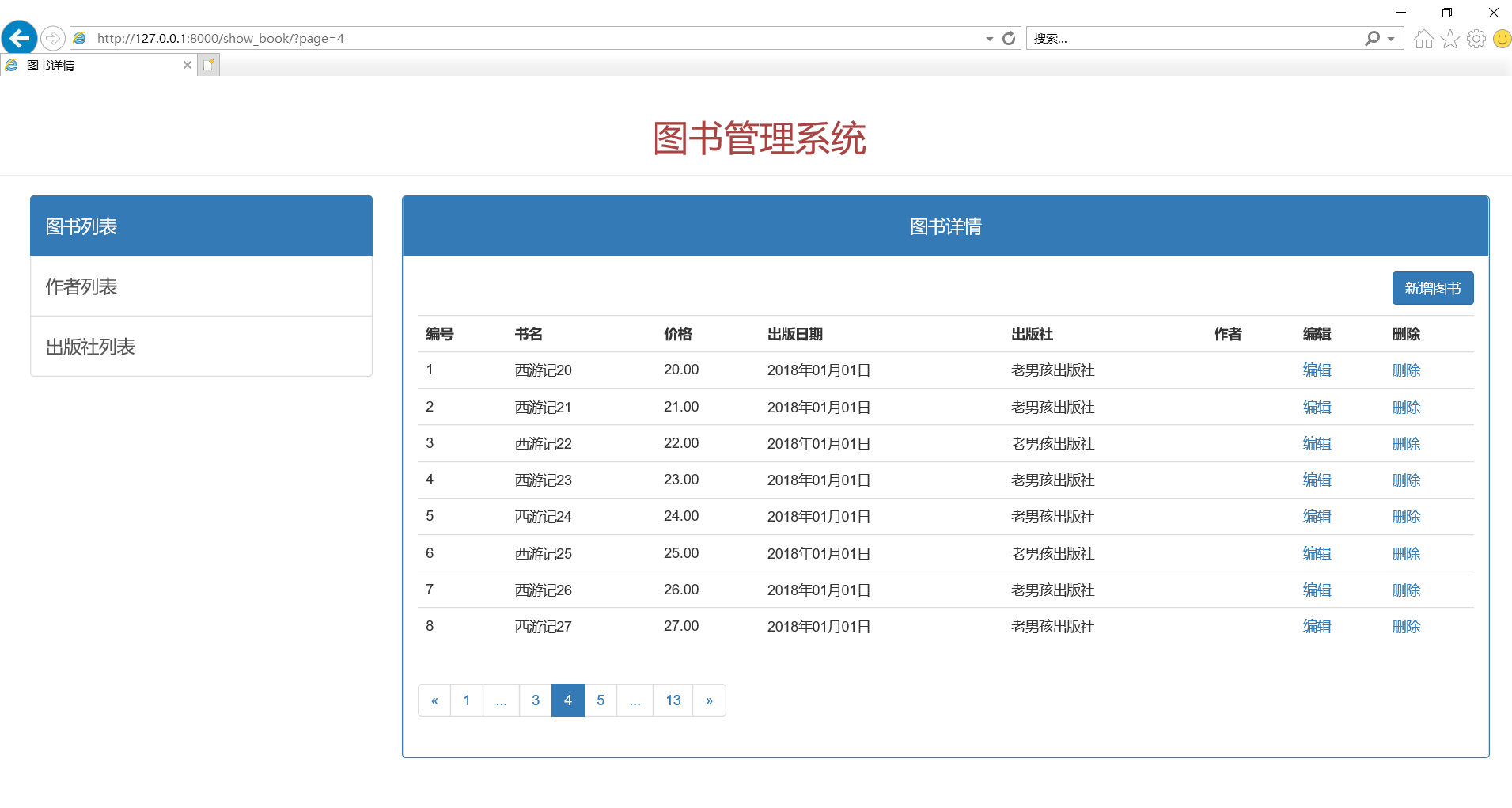有时候在页面中数据有多条时很显然需要进行分页显示,那么在python中django可以这样设置一个分页处理
怎么样去设置呢?
我们要用到 Django 中的 Paginator 组件

后台代码及解析
from django.core.paginator import Paginator # 导入该组件 def show_book(request): title = '图书详情' header = '图书管理系统' book_list = Book.objects.all() paginator = Paginator(book_list, 8) # 将返回前台展示数据进行Paginator操作,一页显示8条记录 count = paginator.count # 对象总个数 print(count) sum_pages = paginator.num_pages # 总分页数 page_range = paginator.page_range # 页码列表(可迭代对象) 也就是可以被循环 # 获取第一页 # 请求链接错误,默认用第一页 主要是防止get请求时候直接写/show_book/?page= 非法字符 try: current_num = int(request.GET.get('page', 1)) # type: str => int except: current_num = 1 # 不在页面范围内的安全处理 主要是防止get请求时候直接写/show_book/?page=超过总分页数或者小于0 if current_num < 1: current_num = 1 return redirect('/show_book/?page=%s' % current_num) elif current_num > sum_pages: current_num = sum_pages return redirect('/show_book/?page=%s' % current_num) current_page = paginator.page(current_num) # 当前的页面 print('>>>', current_page) # 通过page_range控制页数版面,我设置的是中间显示3个标签和前后两页,其他的用...标识,以下为控制逻辑 if current_num < 4: page_range = range(2, 5) elif current_num > sum_pages - 3: page_range = range(sum_pages - 3, sum_pages) else: page_range = range(current_num - 1, current_num + 2) return render(request, 'show_book.html', locals())
前台代码解析
{% extends 'base.html' %} # 继承母版
{% block list %}
<div class="list-group">
<a href="{% url 'show_book' %}" class="list-group-item active">
<h4>图书列表</h4>
</a>
<a href="{% url 'show_author' %}" class="list-group-item">
<h4>作者列表</h4>
</a>
<a href="{% url 'show_publish' %}" class="list-group-item">
<h4>出版社列表</h4>
</a>
</div>
{% endblock %}
{% block table %}
<div class="clearfix">
<a href="{% url 'add_book' %}" class="btn btn-primary pull-right">新增图书</a>
</div>
<table class="table" style="margin-top: 10px">
<tr>
<th>编号</th>
<th>书名</th>
<th>价格</th>
<th>出版日期</th>
<th>出版社</th>
<th>作者</th>
<th>编辑</th>
<th>删除</th>
</tr>
{% for book in current_page %} # 这里要设置为当前的页面对象,和后台对应
<tr>
<td>{{ forloop.counter }}</td>
<td>{{ book.name }}</td>
<td>{{ book.price }}</td>
<td>{{ book.publish_date|date:'Y年m月d日' }}</td>
<td>{{ book.publish.name }}</td>
<td>
{% for author in book.author.all %}
{{ author.name }}
{% if not forloop.last %}
|
{% endif %}
{% endfor %}
</td>
<td>
<a href="{% url 'update_book' %}?id={{ book.id }}">编辑</a>
</td>
<td>
<a onclick="delete_action({{ book.id }})" class="delete-confirm" href="javascript:void(0)">删除</a>
</td>
</tr>
{% endfor %}
</table>
<!-- 分页器 --> # 用jQuery和bootstrap实现
<nav aria-label="Page navigation">
<ul class="pagination">
{# 如果只有一页则不需要上一页和下一页标识#}
<!-- 上一页 --> # 设置上一页的按钮
<li>
{% if current_num > 1 %} # 只有页面大于1才会有效果,否则不能点击
<a href="{% url 'show_book' %}?page={{ current_num|add:-1 }}" aria-label="Previous">
{% else %}
<a href="javascript:void(0)" aria-label="Previous">
{% endif %}
<span aria-hidden="true">«</span>
</a>
</li>
<!-- 第一页页码 --> # 设置第一页显示的按钮
{% if current_num == 1 %}
<li class="active">
{% else %}
<li>
{% endif %}
<a href="{% url 'show_book' %}?page=1">1</a></li>
{# 只有一页就不需要...和中间三页了#}
{% if current_num > 3 %} # 如果页面小于3页就不需要...进行分隔
<li><a href="javascript:void(0)">...</a></li>
{% endif %}
<!-- 中间三页页码 --> # 设置中间三页的代码
{% for num in page_range %}
{% if current_num == num %}
<li class="active">
{% else %}
<li>
{% endif %}
<a href="{% url 'show_book' %}?page={{ num }}">{{ num }}</a></li>
{% endfor %}
{% if current_num < sum_pages|add:-3 %} # 如果点击到最后三页就没必要显示...
<li><a href="javascript:void(0)">...</a></li>
{% endif %}
<!-- 最后一页页码 --> # 设置最后一页的显示按钮
{% if current_num > 1 %}
{% if current_num == sum_pages %}
<li class="active">
{% else %}
<li>
{% endif %}
<a href="{% url 'show_book' %}?page={{ sum_pages }}">{{ sum_pages }}</a></li>
{% endif %}
<!-- 下一页 --> # 设置下一页的按钮
<li>
{% if current_num < sum_pages %}
<a href="{% url 'show_book' %}?page={{ current_num|add:1 }}" aria-label="Next">
{% else %}
<a href="javascript:void(0)" aria-label="Next">
{% endif %}
<span aria-hidden="true">»</span>
</a>
</li>
</ul>
</nav>